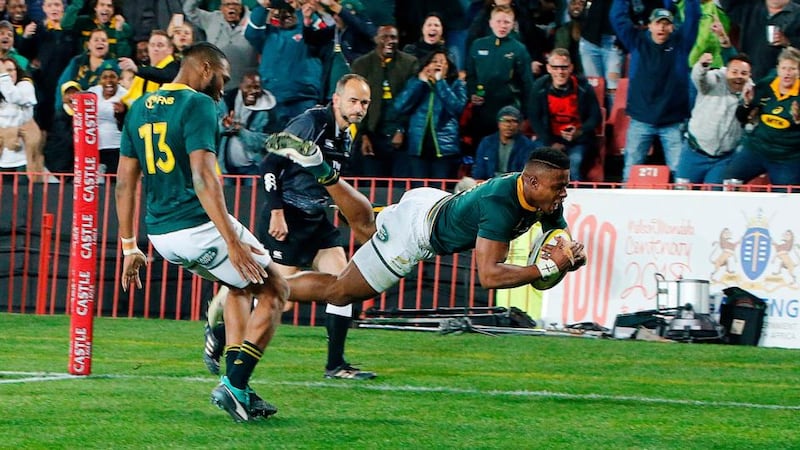Against the Sharks on Saturday, JJ Hanrahan kicked a beautiful penalty for Connacht to secure a win on the road in Durban. It was a match that they had no right to win, which made it all the sweeter for them. And while not a vintage rugby experience it was absorbing to watch.
But instead of lauding the smash and grab by Connacht, it was the return of Aphiwe Dyantyi that caught the eye for me. He has largely gone under the radar, as he started his first match in four years after a doping ban two weeks ago against the Ospreys.
Dyantyi tested positive for three banned substances, all in the general area of growth hormone. At a Springbok training camp in July 2019 he tested positive for metadienone, methyltestosterone and LGD-4033 (commonly known as Ligandrol). His B Sample came back positive that August. He was banned for four years.
And now he’s back. Saturday was his first home game for the Sharks. He didn’t do much in attack – if anything, the game will be remembered for a thumping double tackle on him by Cian Prendergast and Dennis Buckley.
The Counter Ruck: the rugby newsletter from The Irish Times
Ireland casting its net broad and wide to land winning squad for Tbilisi and Lisbon
Gerry Thornley: Stuart Lancaster quite the coup for Connacht and IRFU
Sharks’ shameful antics against Munster betrayed the moral code that makes rugby special
What really struck me though was that his return was so celebrated by the home crowd and the home broadcaster. Dyantyi did very little of note in the game and yet he was interviewed post-match. Nobody was in the least bit sheepish or ashamed about welcoming back a proven doper.
Time and again, South Africa’s record with this stuff is questionable, to say the least. Just this summer, their playmaker Elton Jantjies had to withdraw from the wider Springbok World Cup squad after testing positive for Clenbuterol, another anabolic steroid. In 2020, former South Africa hooker Mahlatse ‘Chiliboy’ Ralepelle was banned for eight years after he tested positive for a banned substance for the third time in a decade.
These aren’t obscure players. Dyantyi was World Rugby’s Breakthrough Player of the Year in 2018. Jantjies and Ralepelle both played for the Springboks on and off for over a decade. Imagine equivalent Irish players serving long doping bans. Imagine the kind of reception they would get when they came back.
Yet here’s Rassie Erasmus on Dyantyi earlier this summer. “I really hope that he comes back with a bang and he does really well for the Sharks. And I hope we can one day pick him for the Springboks again.” Even with the caveat that everyone deserves a second chance, this type of ringing endorsement for a proven doper contributes towards a greying culture of cheating.
It is also worth noting that South Africa narrowly avoided the prospect of having to play the World Cup knockout stages with a ban on displaying their national flag and playing their national anthem. This was due to their government’s non-compliance with the World Anti-Doping Agency code. The process of changing a law can be slow, but surely they should be making it a priority now, as the reigning world champions.

Dyantyi’s major asset is his speed. So let’s talk about speed. Before big data and science really made headway in sport, we used traditional metrics as crude indicators of potential. One of these was the 20-metre sprint test using laser sensors for accuracy. It was always a bit of craic to see who would finish at the top and the bottom of the rankings.
The benchmark to achieve as an outside back was below three seconds – and if you were Denis Hickey, below 2.9 seconds. Those milliseconds are the difference between Hugo Keenan gliding through two defenders on one of his mazy runs. Speed by itself does not make a player a world beater, but when you add it to a high skill level and rugby IQ it becomes a very compelling prospect.
I would have loved to have been faster. I regularly defended against players with better acceleration and top-end speed and I remember how difficult it was. I relied on experience, building shape in defence and using the touchline as an extra defender. There was always satisfaction in marginal improvements while your body could sustain the workload. But eventually, time catches up and it is terminal in a sporting context.
My final six months in rugby – and in particular my last match – I remember vividly having to chase sideways in defence because I wasn’t able to move quickly enough the way I used to. This opened up my inside shoulders and I was getting beaten by better, quicker movements. It was the cathartic moment when I realised I was too slow to play the game anymore.
My ability to move quickly with decent footwork let me play a game I loved. Perhaps naively, I believed or expected that every other player was honest in their endeavours. The decision to dope – and let’s be very clear it is a decision – has ramifications that really hit home. Both in the short term and the long term.
Yes, Dyantyi has served a four-year ban. But he does not lose the physical benefits of doping. His speed is artificially increased and that still gives him a comparative advantage against players who have made a decision to stay within the rules of our sport.
South Africa won so many supporters over the last two World Cup cycles. As back-to-back world champions, they should be setting the gold standard when it comes to doping. Instead, they have chosen a more laissez-faire attitude to enforcement and there doesn’t seem to be a culture of condemnation. Instead, the message to young players seems to be – cheat and you will be okay.
That can’t be good enough.
















